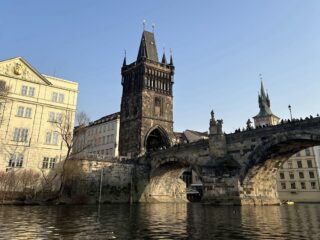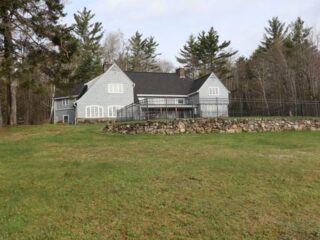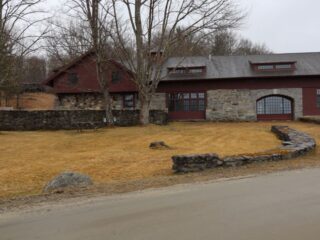by Mac Carey
The small historic town of Leesburg Virginia certainly doesn’t bring forth my atavistic desires and primordial rage, even less so does the stately Glenfiddich house, situated in the middle of the sprawling antebellum lawns and pillared front porches of North King Street. But from 1966-1968, the town, and the small room on the second story above the entranceway, served as the surroundings for James Dickey while he wrote his 1970 masterpiece about man’s darker instincts, Deliverance.
Growing up in Leesburg in the past twenty years, I’ve seen many changes. I’ve witnessed the once farm-based community fall victim to the suburban sprawl of Washington DC, thirty-five miles east. Fifty miles in the opposite direction are the scenic mountain ranges of the Shenandoah, and the town touches the fringes of horse country and is a major point along the Mid-Atlantic antique belt.
But within Leesburg proper, an idyllic county seat, the charm remains. For me Leesburg has always managed to find the balance between bucolic charm and stimulating sophistication. Even the immediately surrounding newer area remains clean and regulated. The historical center is comprised of two streets lined with Dutch style and Italianate buildings containing china lined antique shops, bourgeoisie bistros, and shabby chic women’s boutiques.
It was in one of those bourgeoisie bistros that I learned of Dickey’s connection to the town. Having not read the book, only having seen the 1972 John Boorman movie, I was surprised. After finishing the 300-page treatise on the nature of man, the boys of Lord of the Flies turned middle aged, I was astonished. On that street? The one lined with flourishing elms and people so wealthy and elusive you never saw them at the mailbox? Granted it was forty years ago, but the place hadn’t changed that much.
While Leesburg may have grown drastically in the past few years, the historic side street that Glenfiddich house sits on has not. Despite my own sketchy southern credentials, the antebellum lifestyle floods back to even me whenever I drive down North King Street, and see the stately homes set back with the wide white porches perfect for a mid-afternoon break with a mint julep. So what was it about this southern home, far from the Faulknerian wilderness of the Deep South, closer to the structured feudalism of hunt country with its lords and ladies and event calendars, which helped Dickey write his magnum opus?
When Dickey moved to the house he proclaimed that he had returned to his southern roots. But Dickey’s roots were in Alabama and Mississippi, not the anglophilic plutocracy I know of Virginia horse country, where a young Jackie O’Nassis had plied the fields for the annual fox hunts. But the house was certainly convenient. It was a short drive into DC, where Dickey served as poetry consultant to the Library of Congress, communicating with such luminaries as John Updike and Peter Taylor.
Inspiration aside, I wonder about the impeccable time management skills needed to complete the novel. Dickey’s career had exploded in the few years leading up to the move from California to Virginia. His poems had achieved critical acclaim and were consistently published by the New Yorker. He certainly kept himself busy. In one letter in 1967 he wrote that “I have been enormously and confusingly busy . . . and have had no time to write to anyone but those whom the government obligates me to write.”
The yellow house with black shutters and sixteen rooms also served his family well, which by then had two young sons in it. There are photographs of Dickey’s two sons playing in the snow, picking berries from the bushes, and frolicking in the spacious backyard. The house is nearly identical to the one in the black and white photographs, with the exception of some better-developed shrubbery. Despite the other constant changes of a mushrooming Leesburg, I can always count on Glenfiddich, like the rest of North King Street, for its unchanged reliability, like my mom’s cooking or winter colds. Though the outside may be the same, the inside now services the metro area’s business elite through morale meetings and teamwork coaching seminars run by suited yuppies who would have crossed the street if they had run into the home’s earlier inhabitant.
But halcyon surroundings aside, books like Deliverancedo not come out of vacuums. Like all poets, Dickey had enough personal demons that any home or town, no matter how idyllic or charming, couldn’t vanquish them. Already larger than life, Dickey couldn’t become big enough in his own psyche. So the strapping man’s man had to invent stories of bear wrestling and near death experiences to impress reporters – and himself. When that wasn’t enough, he turned to alcohol. He became distant from his wife and children.
Deliverancewas published in 1970 to great acclaim and the movie two years later handed Dickey even greater fame, though none of his subsequent novels would approach his early success. Dickey had long been a heavy drinker; it was drink that finally took him, in the form of cirrhosis of the liver at age 73. Stare into the abyss long enough and the abyss stares back at you.
Dickey would move on after his two-year respite in Leesburg to a university teaching position, where he completed the majority of Deliverance. But the first drafts – which Dickey described as so different from his expressive, rhythmic experience with poetry that it was like wearing a wooden overcoat – were scrawled in the evenings in a small room in the upstairs of the shrub encircled Glenfiddich house.
I still take occasional nighttime walks down the streetlamp lit North King Street. And when I pass the yellow home set back from the sidewalk, I always glance at the window upstairs, above the pillared front entrance. And I think of Dickey, his large frame hunched in a chair, drink in hand, straining against any of the rhythmic comforts of poetry, steeling himself to face the abyss, and report it back in the stripped down metallic language he knew it deserved.








